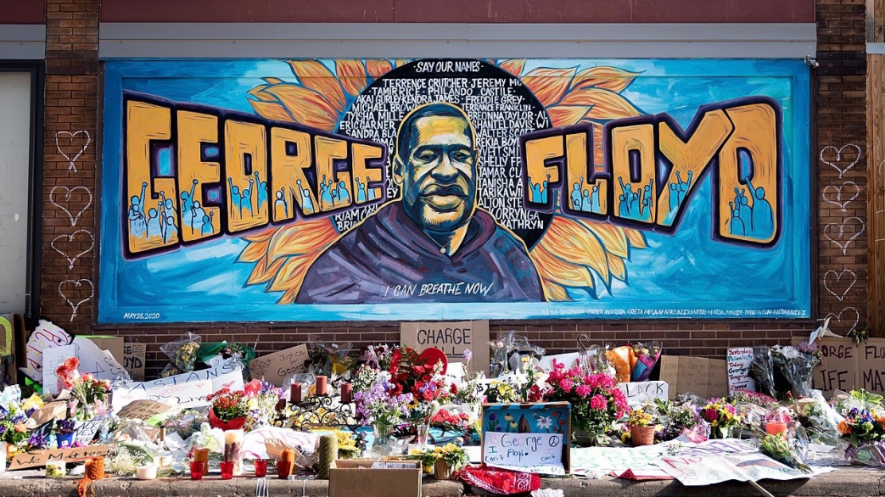George Floyd and Iconoclasm in the Western World

File Photo.
The iconoclasm sweeping the Western world, particularly the USA, is unique in spirit and purpose. But the phenomenon of destroying and damaging statues and images is not new in itself.
Iconoclasm is steeped in history and rooted in human hubris. When human society formed kingdoms, rulers wanted to be immortalised by statues which were placed in places of worship whereby kings and warriors were elevated as gods. The ancient world revelled in building images of conquerors. Great art and sculpture grew from this proud political impulse. When new lands were invaded and empires built, statues were erected to subdue the conquered people. Asia, Africa, and Latin America are littered with such reminders of alien power.
But conquerors were not content to glorify themselves. Self-glorification was attended by contempt for the conquered. When kingdoms and city-states were invaded statues and images of the vanquished were defaced and destroyed. It was a political act. This tradition of religious iconoclasm—destroying images for political and religious reasons—probably began in Egypt when the Pharaoh Akhenaten initiated a monotheistic religion that worshipped the sun god, Aten. He ordered destruction of images of other gods. But after his early death the priests reinstated the traditional gods and goddesses.
Political iconoclasm was displayed in Nineveh (present-day Iraq) when the invading and victorious Medes destroyed the statue of an Akadian king. Ashurbanipal, an Assyrian king of 7th century BCE continued the tradition. Around 1500 BCE the Greek armies invaded the rich Trojan empire and burnt the citadel. Troy was never rebuilt. Their past grandeur can be glimpsed in the ruins at Hisarlik in Turkey. When the Persian king Darius led his irresistible army up to Athens he set fire to the Acropolis which represented Hellenic pride. When Alexander of Macedon defeated the Persians he retaliated by destroying the splendid city Persepolis. The Romans displayed their vindictive spirit when they razed the Phoenician cities of Carthage and Baalbek to the ground.
Greeks and Romans carried their architecture and sculpture to the lands they conquered. From their northern-most garrison towns in Trier Germany to southern colonies in Syria they have left behind monuments. It was poetic justice when a new and assertive faith—Christianity—built churches to Christ and his apostles on Roman temples to Zeus and Venus.
Early Christian rulers built churches atop Roman pagan temples and monuments. This way they saved expenses for the foundations which were provided by sturdy Roman marble. Sometimes the domes were also retained and refashioned to make churches. The new ones that were built adopted Greco-Roman styles of architecture. The most notable is the Basilica of St. Paul in Rome, whose structure is entirely classical Roman. Many such adaptations can be seen in the churches of Eastern Europe, Syria and Iraq.
The fiercest iconoclasm came with the advent of Islam. It began in Spain in the 8th century when Moorish conquerors built mosques on Christian edifices. The Giralda in Seville was first a church, then a mosque, and once more a church built by Queen Isabella. She instructed the builders to ensure that nothing more could be built on the rotating tower or giralda. As amity began between the two races Christian churches and palaces were built in the Moorish style. The Mesquita at Cordoba is an example of where the two faiths and styles met to create a unique structure—half mosque, half church.
During the Middle Ages, India witnessed fierce iconoclasm by invaders from her north west frontier. Sometimes the temples were razed to the ground, at others mosques were built on the existing structure, as happened in Europe and Asia Minor.
An interesting event occurred when the Ottoman Turks invaded the Byzantine Empire in 1453, and churches were converted into mosques. The grandest of these was the basilica Hagia Sophia built by Emperor Justinian in the 5th century. This magnificent church was the citadel of Eastern Christianity with murals and icons on walls, domes and altar. Though Sultan Mehemet converted the great church into a mosque and added Islamic embellishments, he did not destroy or damage the altar, murals and icons. In 1923, another great Turk, Mustafa Kamal Pasha, turned the church-mosque into a museum and a heritage site. President Erdogan has now proposed the church of Hagia Sophia, which was converted into a mosque and then as a museum should be made once more into a mosque.
The Islamic State terrorists perpetrated the most heinous iconoclasm in the cradle land of human civilisation. As the black-clad hordes drove into Syria and Iraq they destroyed the ancient heritage sites of Palmyra, Nineveh, Nimrud, and broke into museums where the heritage of mankind was housed. They smashed statues and sculptures dating from the fifth millennia BC. The damage is incalculable. The reason for this is that the Islamist terrorists believe all pre-Islamic heritage is profane. What a contrast they are to the Christian Greeks and Italians who have proudly and lovingly preserved their classical pagan past and the Muslim Egyptians their ancient heritage.
Ironically the systematic preservation of monuments in India, damaged by time and invasions, began under British rule. And we Indians who do not display triumphalism, in turn have preserved edifices of the British Raj.
The iconoclasm we see today in the USA and parts of Europe is a different story. The rage which provoked tearing down of statues sprang from injustices and insults borne in sullen silence for several centuries. The statue of a slave trader has been pulled down in Bristol to loud applause. Central London saw crowds rushing to tear down statues of well known racists and empire builders in Parliament Square. Churchill’s pugnacious statue was therefore hastily boarded up. In the USA, statues of Confederate warriors who fought for the perpetual enslavement of Afro-Americans are being pulled down. A statue of Christopher Columbus was pulled down in Maryland, USA, on the ground that this man began the colonisation of the Americas which led to the destruction of the culture and traditions of the indigenous people. Princeton University has decided to remove memorials to President Woodrow Wilson who supported segregation of Black people. Statues of American once held in esteem and housed in Capitol Hill are under stern scrutiny in case they have harboured racist beliefs and acted incorrectly.
Faced with this surge of popular rage, not just among Afro-Americans but White Americans as well, Donald Trump put one more nail on his election coffin by passing an executive order declaring these defiant gestures as illegal. He said that “these anarchists are destroying American history.” To which the original inhabitants of America retorted that their history and heritage had been systematically wiped out. Boris Johnson huffed and puffed expressing unrighteous indignation unwilling to admit that he, Trump, and Bolsanaro are on the wrong side of history.
There are others such as Princess Marie Esmeralda of the House of Saxe-Coburg Gotha, great grand-daughter of the infamous King Leopold II of Belgium, who has displayed courage and honesty in her statements in a BBC program. She apologised for the atrocities committed by Belgian soldiers, administrators, industrialists in Africa and particularly in the Congo during the rule of her ancestors.
To objective non-partisan spectators the demolition of statues of men who upheld unworthy causes—racism, slavery, exploitation of workers and murderers glorified as heroes against defenceless people—seems like a cleansing process. It is as if decent human beings, seeing possible extinction on the horizon, would like to see past events and people through the harsh lens of unforgiving history.
The author is a retired civil servant and writes on international history. The views are personal.
Get the latest reports & analysis with people's perspective on Protests, movements & deep analytical videos, discussions of the current affairs in your Telegram app. Subscribe to NewsClick's Telegram channel & get Real-Time updates on stories, as they get published on our website.























